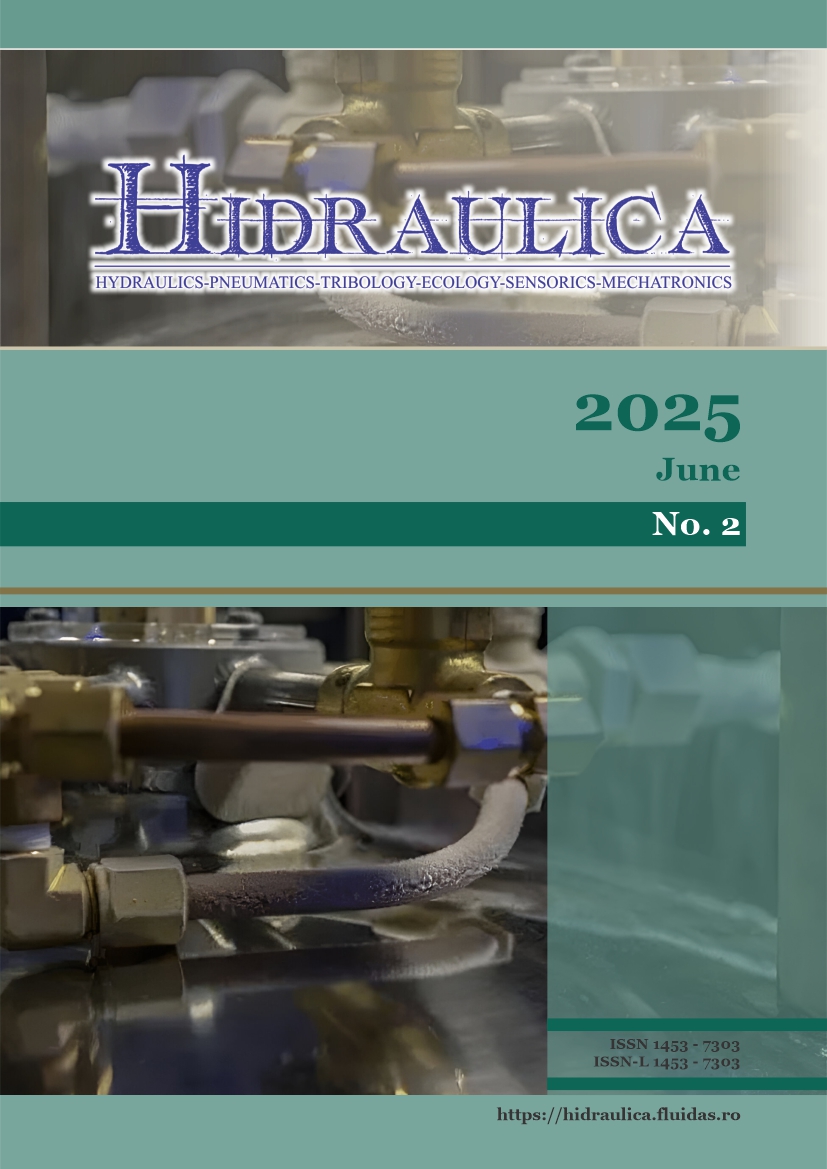CURRENT ISSUE – HIDRAULICA Magazine No. 2/2025
 Tribological Mechanisms in Water Hydraulic Axial Piston Pumps: Insights into Lubrication, Cavitation, and Wear Control
Tribological Mechanisms in Water Hydraulic Axial Piston Pumps: Insights into Lubrication, Cavitation, and Wear Control
Author: Ștefan ŢĂLU
Water hydraulic axial piston pumps (WHAPs) represent a critical innovation in eco-sustainable fluid power systems, yet their tribological behavior under water-lubricated conditions remains a persistent engineering challenge. This study provides a focused review of three key tribological mechanisms – hydrodynamic effect, cavitation effect, and wear debris storage – essential to understanding and optimizing the performance of friction pairs in such pumps. Under hydrodynamic and mixed lubrication regimes, surface textures induce convergent and divergent geometries that generate … (read more)
Modeling and Simulation of the Operation of the Hydro-Pneumatic Accumulators
Author: Anca BUCUREȘTEANU
This paper introduces some mathematical models and simulations of the operation of the hydro-pneumatic accumulators from the hydraulic actuation systems. There are presented static but also dynamic models that can be used in the design of the hydraulic units. The operation in dynamic mode was simulated by means of specialized programs such as Matlab/Simulink and Automation Studio. A real, numerical example, which was the basis for … (read more)
Synthesis of Elevator Mechanisms in X with Complex Triad Type Kinematic Chains
Authors: Dana Mirela VĂLEANU, Păun ANTONESCU
The mechanisms of the elevators in X usually have a simple structure with hinged, scissor-type bars, having one or more levels. In the last period, models of elevators with articulated bars in X with complex structure with triad type kinematic chains were made. For such an elevator with triadic chains, a construction diagram (dimensioned drawing) is presented, after which the kinematic diagram of the plane mechanism with articulated bars and guided rollers is executed. The structural-topological analysis aims at … (read more)
Optimizing Energy Efficiency in Closed-Circuit Hydrostatic Transmissions: Advancing Charge Pump System Control
Authors: Alexandru-Polifron CHIRIȚĂ, Radu-Iulian RĂDOI, Bogdan-Alexandru TUDOR-ROTILĂ, Ștefan-Mihai ȘEFU
While closed-circuit hydrostatic transmissions (HTs) achieve remarkable efficiencies (≤98%) in their main pump-motor units, auxiliary charge pump systems remain a significant source of avoidable energy loss. This review synthesizes current research to demonstrate that conventional fixed-operation charge pumps-operating continuously at ~25 bar pressure and 10–20% of main pump flow-waste substantial energy due to misalignment with actual system demands. Charge pumps perform critical functions: compensating for internal leakage, providing filtration/cooling, supplying servo-control pressure, preventing cavitation, and ensuring lubrication. However, their static operation causes … (read more)
Greywater Pretreatment Prototype Calibration with Integrated Filter
Authors: Víctor ORTIZ, Faustino DE LUNA, Margarita PRECIADO, Maritza ARGANIS, Daniel ABSALÓN, Edgar DE DIOS, Omar CABRERA, Valeria CHÁVEZ, Edgar MENDOZA, Rodolfo SILVA
The sustainable management of greywater in decentralized systems is critical for regions facing water scarcity, particularly in isolated coastal communities. This study presents the calibration of a gravity-driven greywater pretreatment prototype equipped with a sargassum-based filter, designed to optimize water reuse while minimizing energy consumption. The system was retrofitted with high-resolution digital and mechanical manometers (Instrutek D600 and M-300) and Keller pressure cells to precisely measure local head losses. Laboratory experiments were coupled with numerical simulations in EPANET to calibrate the prototype, focusing on the hydraulic performance of the biodegradable filter. Results demonstrated … (read more)
Simulation and Improvement of Hydraulic Systems with FluidSim
Authors: Tiberiu AXINTE, Edmond MAICAN, Mihăiță CAZACU, Elena Gabriela CURCĂ, Lidia CALANCEA, Mihai DIACONU
The paper presents the importance of the hydraulic systems. The article contains material on the study of the basics of hydraulics: Pascal’s law, Navier-Stokes equation and Darcy-Weisbach relationship. Besides, in this article we present two hydraulic circuits. In fact, the design and simulation of these circuits are prepared in the FluidSim software from Festo. Thus, the first hydraulic circuit is composed of … (read more)
Implications of Technology in Everyday Life: From the Principles of Domotics to the Functionality of the Smart (Green) Home
Authors: Bogdan V. CIORUȚA, Ioana-Elisabeta CIORUȚA, Mirela-Ana COMAN, Claudiu D. FILIP, Alexandru L. POP
This article explores the profound implications of technology in everyday life, with a particular focus on the evolution of homes, from the initial concept of home automation to that of the smart home and, finally, to the essential vision of a smart (green) home. The introduction highlights how technology has redefined the comfort, efficiency, and sustainability of the home space, transforming homes into complex and interconnected ecosystems. The review of the specialized literature details the dynamic landscape of innovation in the home automation sector, referring to the major contributions of global companies, alongside other entities with expertise in the field. At the same time, prestigious academic journals and conferences are listed, which attest … (read more)
Comparison of Two Forecasting Methods for Inflow Volume at the La Angostura Dam, Chiapas, Mexico
Authors: Maritza ARGANIS-JUÁREZ, Margarita PRECIADO-JIMÉNEZ, Alejandro MENDOZA-RESÉNDIZ, Héctor BALLINAS-GONZALEZ
Forecasting inflow volumes is a critical component of reservoir management, enabling efficient planning and mitigation during periods of hydrological extremes. This study evaluates two contrasting approaches to inflow volume prediction for the La Angostura Dam in Chiapas, Mexico. A seasonal decomposition model developed using Excel©’s FORECAST.ETS function, chosen for its simplicity and accessibility. An Artificial Neural Network (ANN) created in Matlab©, aimed at capturing nonlinear dynamics inherent in hydrological datasets. Both models were trained on historical data (1960–2020) and assessed for forecasting performance (2021–2024). While the ANN demonstrated … (read more)
Optimizing Irrigation Efficiency through Modern Techniques and Computational Modelling
Author: Fănel Dorel ȘCHEAUA
In order to ensure efficiency in modern irrigation of agricultural lands, several key parameters must be monitored and optimized, while these parameters contribute to reduce water wastage, improve crop yield and promote general sustainability. The basic irrigation parameters are related to soil moisture content, evapo-transpiration (ET) rate, crop water requirements, irrigation scheduling, water application efficiency, system maintenance and … (read more)